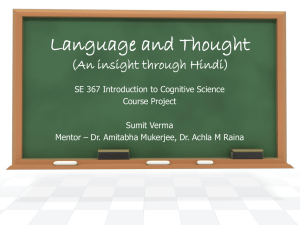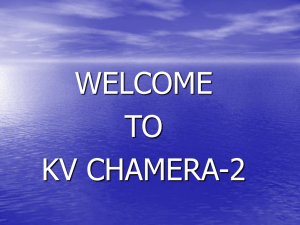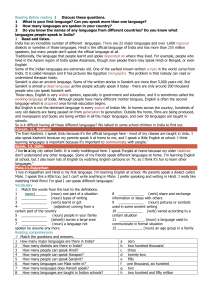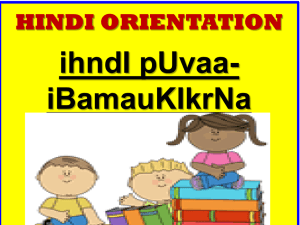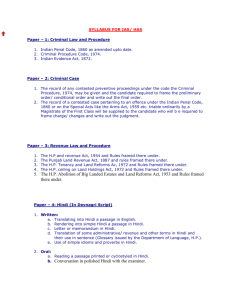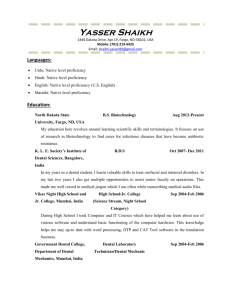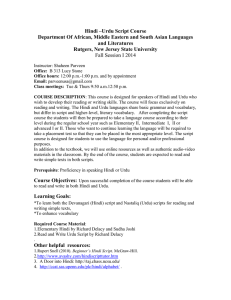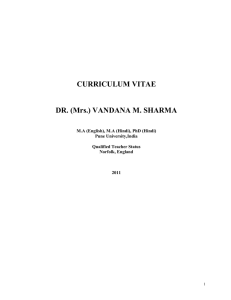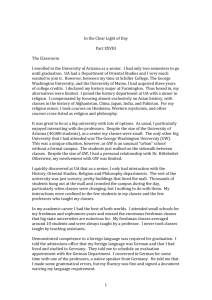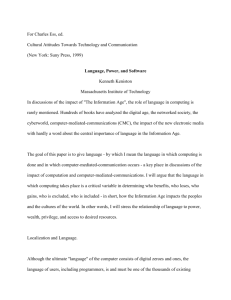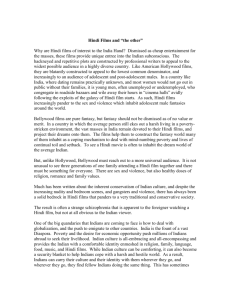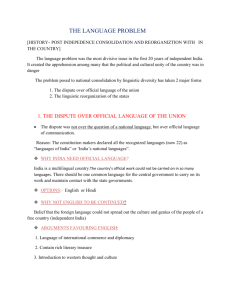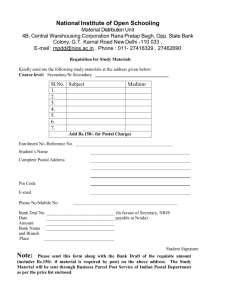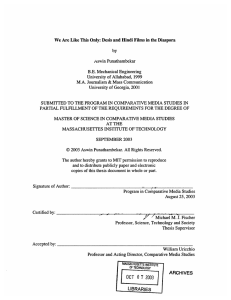Week 2 - course notes
advertisement
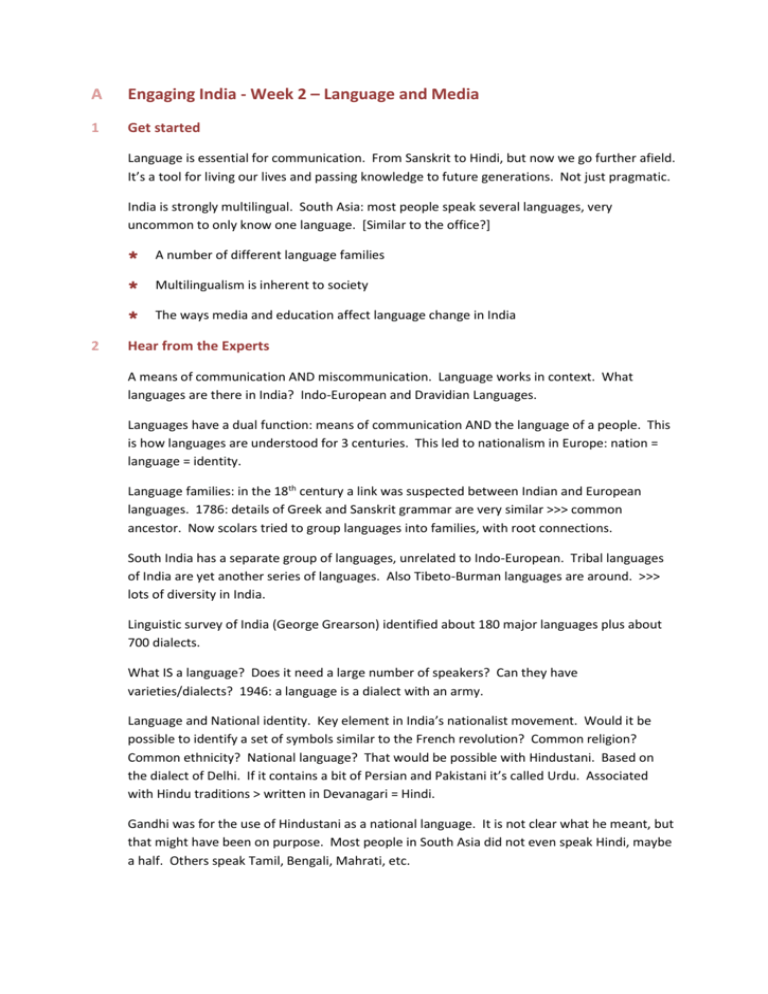
A Engaging India - Week 2 – Language and Media 1 Get started Language is essential for communication. From Sanskrit to Hindi, but now we go further afield. It’s a tool for living our lives and passing knowledge to future generations. Not just pragmatic. India is strongly multilingual. South Asia: most people speak several languages, very uncommon to only know one language. [Similar to the office?] 2 A number of different language families Multilingualism is inherent to society The ways media and education affect language change in India Hear from the Experts A means of communication AND miscommunication. Language works in context. What languages are there in India? Indo-European and Dravidian Languages. Languages have a dual function: means of communication AND the language of a people. This is how languages are understood for 3 centuries. This led to nationalism in Europe: nation = language = identity. Language families: in the 18th century a link was suspected between Indian and European languages. 1786: details of Greek and Sanskrit grammar are very similar >>> common ancestor. Now scolars tried to group languages into families, with root connections. South India has a separate group of languages, unrelated to Indo-European. Tribal languages of India are yet another series of languages. Also Tibeto-Burman languages are around. >>> lots of diversity in India. Linguistic survey of India (George Grearson) identified about 180 major languages plus about 700 dialects. What IS a language? Does it need a large number of speakers? Can they have varieties/dialects? 1946: a language is a dialect with an army. Language and National identity. Key element in India’s nationalist movement. Would it be possible to identify a set of symbols similar to the French revolution? Common religion? Common ethnicity? National language? That would be possible with Hindustani. Based on the dialect of Delhi. If it contains a bit of Persian and Pakistani it’s called Urdu. Associated with Hindu traditions > written in Devanagari = Hindi. Gandhi was for the use of Hindustani as a national language. It is not clear what he meant, but that might have been on purpose. Most people in South Asia did not even speak Hindi, maybe a half. Others speak Tamil, Bengali, Mahrati, etc. The context would determine which language is being used: English, Hindi, local language and dialect. When Pakistan was formed, it had two parts: but Urdu was decided as the national language. In East Pakistan people spoke Bangla, in West P. it was Sindhi, Punjabi, Pashtu, etc. In Pakistan more than half speak Urdu, more and more people speak Hindi in India. Multilingual culture in India. Most English speaking cultures are unilingual (ex: UK). In a number of countries most people are multilingual. We also speak slightly differently within a language depending on the person I address. Different registers. In India this goes further: different languages for different registers. English, Hindi, local language. Today more English is spoken in India, but code-switching still happens as much as in earlier times. Another aspect: sometimes people use languages because the family came from there and they use the language to maintain their identity. There is also code-switching in the written language. Classical Indian drama typically uses more than one language, or different dialects. The change is more about the place of each particular language rather than a mashing up of languages. Language depends where you are, who you are and who you are speaking to. Language change and media. Indian cinema industry developed out of popular drama (traditional), that had high and popular forms. The popular form interacted to create the Parsi Theatre (resembling western theatre) >>> speech, dance and music have to be part of Indian drama. This Parsi Theatre developed into moving pictures after contact with European moving pictures. In 1913 the first Indian movie was made, a story based on classical Hindu tradition. Next one was a love story in HINDI. Basis of the later film industry. Modern Indian movies have become a unifying force, all India enjoy watching HINDI films, even world-wide. The original moving pictures + Indian traditions = something that is larger than the sum of its parts. Print Media. Only important since the mid-19th century, because paper was very expensive. Printing was also very expensive. Technology and materials became cheaper only mid-19th century. >>> very early, Indian languages were used for print. Constraints: social constraint = press is an inciandery device against the British. The letter press works for English, but for Indian languages this is not as simple due to the alphabets. With computerisation, this became much simpler to be produced. 1990: This led to a lot of people reading non-English newspapers, while the number of readers of English readers has not really changed from its original 5-10%. Initially, many editors set out to create a form of language that is educational and inspiring. Today, the press uses the language that attracts the reader. From more formal > popular. Hindi has increased its use rather than being suppressed by print media. At the same time, the Indian economy was liberalised. How do we advertise to the masses? With local Hindi newspapers, a larger market could be reached, of course. This was a powerful driver for development of print media. Interaction also with tv industry. TV introduction in the 1950s: state run, only in major cities, rather boring. In the 1980s, satellite tv came along. This allowed for the whole of India to watch tv. Unusual model from the rest of the world: local distribution was done through disks on neighbourhood level. Will people only watch tv, but not movies or read print? Each of those formats worked to the advantage of the two others. This also fuelled the sustained growth of the local languages and Hindi as opposed to English. Mass media. Is by definition multilingual. The same papers and magazine appear in multiple languages. English is not actually replacing the other languages, but added to a choice of different languages in South Asia. Communication aspect Community aspect Language cannot be separated from commerce, media, advertising Nationalist movement = united country, multilingual community as well Diversity is used to create more than the sum of the parts. 3 Go deeper Diverse reading materials. 4 Discuss a Discuss whether India's linguistic diversity is a strength or a weakness in India's national identity and in its interaction with the wider world. My feeling is that linguistic diversity is an asset not only for the national identity, but especially for interaction with the world at large. Linguistic diversity is also an indication of cultural and/or ethnic diversity, of course. Any person who is used to interacting with others of a different language and/or culture is likely to be able to look beyond their own little world, being confronted with other ways of thinking, doing, thinking and expressing themselves on a regular basis. The idea that not everybody is alike is engrained in the mind from early on, so confrontation with the “different” will likely have a much less negative effect than it would have on someone who is used to all the people around him being very similar, talking the same way, living the same way. This would benefit any kind of outside interaction. Contact with other countries would theoretically be hindered much less by the feeling of being different – this is normality as many people within India are different, too. So contact could run much more smoothly. On the linguistic side of the subject of diversity it could be considered a drawback that a multitude of languages prevails in India – but then most people, especially those with international ambitions, are able to speak English as a matter of fact, which is more than can be said for many other nations, where English is taught as a foreign language. In India, English – as has been mentioned in the lectures – has managed to insinuate itself as yet another option, which now plays in favour of trade and international connections. When it comes to national identity, this would appear to be a hindrance at first, but once it is realised that diversity can be a strength as there is always someone just similar enough to identify with and absolute uniformity could not possibly be an aspiration in the first place, it becomes clear that national identity can also be based on the fact that “we are able to accept the differences” rather than “we do not want any differences” as is the case in many countries where centralised government has been trying to eradicate differences by any means possible. Diversity also means vibrant cultures that influence and invigorate each other through their differences, by injecting each other with new ways of thinking, doing and expressing themselves. 5 Test 6 Summing up



